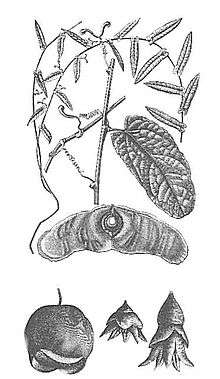Alsomitra macrocarpa
| Javan cucumber | |
|---|---|
.jpg) | |
| Scientific classification | |
| Kingdom: | Plantae |
| (unranked): | Angiosperms |
| (unranked): | Eudicots |
| (unranked): | Rosids |
| Order: | Cucurbitales |
| Family: | Cucurbitaceae |
| Genus: | Alsomitra |
| Species: | A. macrocarpa |
| Binomial name | |
| Alsomitra macrocarpa (Blume) M.Roem. | |

Meyers großes Konversationslexikon
Alsomitra macrocarpa ('also'=grove, 'mitra'=mitre/fillet) or Javan cucumber is a gourd-bearing liane, belonging to the pumpkin family from the tropical Asian forests of the Malay Archipelago and the Indonesian islands. Alsomitra is a genus of 12 species of vines found in Southeast Asia, Australia and South America.
The fruits or pepos are also remarkable in that they are football-sized (about 300mm diameter) and bell-shaped, suspended high in the forest canopy, and densely packed with large numbers of papery winged seeds, falling from the underside of the fruit and gliding long distances when mature.[1][2]
The plant was first described under the name Zanonia macrocarpa in 1825 by Carl Ludwig Blume from fruiting material collected on Mount Parang in Java. In 1843 Max Joseph Roemer published it under the name Alsomitra macrocarpa, including 7 other ill-fitting species in the genus, a genus he did not define. In 1881 Alfred Cogniaux allocated the species to Macrozanonia macrocarpa.[3][4] The current accepted name is Roemer's Alsomitra macrocarpa.[5]
Seed propagation
The seed or samara of this species is unusual in having two flat bracts extending either side of the seed to form a wing-like shape with the seed embedded along one long edge and the wings angled slightly back from it. As the seed ripens the wings dry and the long edge furthest from the seed curls slightly upwards. When ripe, the seed drops off and its aerodynamic form allows it to glide away from the tree.[6][7] The wing spans some 13 cm and can glide for great distances. The seed moves through the air like a butterfly in flight - it gains height, stalls, dips and accelerates, once again producing lift, a process termed phugoid oscillation. In the past it was often found on the decks of ships at sea.
The seed's relative stability in pitch and roll inspired Igo Etrich, a pioneer of early aviation. The contemporary pioneer J.W. Dunne also studied the seed but discarded it as inspiration because it was not directionally stable.[8][9]
See also
External links
References
- ↑
- ↑
- ↑ "Macrozanonia Macrocarpa". 1920: 197–199. JSTOR 4118666.
- ↑ J. Hutchinson; "Macrozanonia Cogn. and Alsomitra Roem", Annals of Botany Volume 6 Issue 1, 1942, pp. 95-102.
- ↑ Royal Horticultural Society
- ↑ Walker, P.; "Early Aviation at Farnborough, Volume II: The First Aeroplanes", Macdonald (1974), Pages 174-175.
- ↑ Azuma, Akira; Okuno, Yoshinori (1987). "Flight of a samara, Alsomitra macrocarpa". Journal of Theoretical Biology. 129 (3): 263–274. doi:10.1016/S0022-5193(87)80001-2.
- ↑ Dunne, J.W.; "The theory of the Dunne aeroplane", The aeronautical journal, April 1913, pp83-102 (reproduced in Flight over several issues from 16 August 1913): "Violently opposed to the Zanonia type in most characteristics are the wing forms in ... the division to which I have given most of my attention since 1904."
- ↑ Review of Raleigh's "The War in the Air", Aeronautical Journal, July 1922, p243.